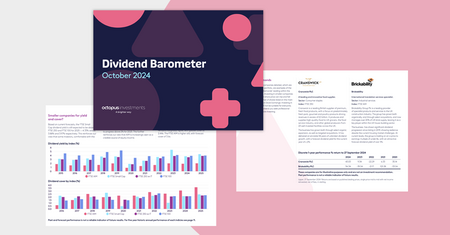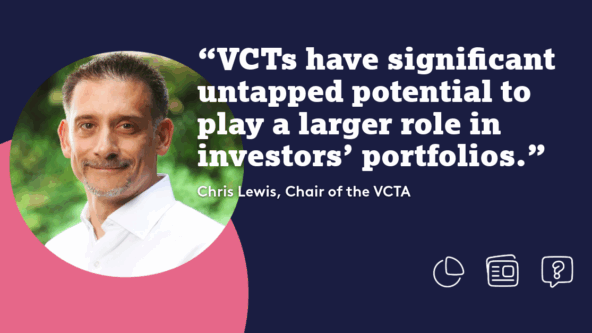The personal tax landscape has changed drastically in the last few years, with implications for both clients and advisers. Frozen income tax thresholds and reducing tax-free allowances on savings, capital gains and dividends has created an environment where returns from non-tax efficient investments have become less compelling.
Savings rates on cash of 5% or investments with a consistent dividend yield appear attractive to customers, but once tax has been deducted how attractive are the returns in reality?
How can advisers cope with this increasing challenge?
Advisers may consider tax efficient investments for their clients. The enhanced level of research required to recommend these investments certainly justifies the time taken to consider and advise on them.
It’s with this backdrop that Venture Capital Trusts (VCTs) warrant special attention this year.
Tax relief and high growth potential
VCTs are listed companies that back a range of pioneering, early-stage businesses. They foster innovation in the UK by providing long-term capital to smaller, unquoted, and AIM-listed companies. These types of companies can face challenges, so VCTs offer attractive tax reliefs to compensate investors for some of the risk involved.
Provided shares are held for at least five years, VCT investors can claim 30% upfront income tax relief on up to the first £200,000 invested each tax year. And VCTs typically target a 5% yield paid out as tax free dividends each year. If the performance of the VCT is very successful, it may also pay special dividends, and any incremental growth is free from capital gains tax.
When compared to a 5% VCT dividend, a non-tax efficient investment would need to pay around an 8% annual dividend to generate an equivalent post tax income for investors. If the benefit of initial income tax relief is also factored in, a non-tax efficient investment would need to pay around an 18% annual dividend to create an equivalent post tax outcome. This assumes the 30% upfront income tax relief is spread across the five-year minimum holding period.
We’ve shown how this looks for an additional rate taxpayer in the table below.
*Assuming dividend allowance used elsewhere
| VCT | Non-tax efficient investment | |
|---|---|---|
| Initial investment | £10,000 | £10,000 |
| 30% income tax relief spread over five-year minimum VCT holding period | £600 | N/A |
| 5% target VCT dividend paid | £500 | N/A |
| Dividend needed to deliver equivalent annual outcome – 18.1% | N/A | £1,814 |
| Dividend Tax for an additional rate taxpayer (39.35%)* | N/A | £(714) |
| Annual outcome after tax | £1,100 | £1,100 |
The example assumes no loss or gain on initial investments and does not factor any initial or exit charges. Returns and tax reliefs are not guaranteed. VCT investment is likely to have a higher-risk profile compared to a mainstream, non-tax efficient investment fund. A non-tax efficient investment can be held within an ISA, in which case it would benefit from tax free dividends. However, annual ISA contributions are limited to £20,000 a year.
The significance of tax reliefs
VCTs can make for an attractive income planning tool due to the combination of upfront tax relief and tax-free dividends. Investors can access higher levels of post-tax target returns associated with higher risk investing, while benefitting from the available tax reliefs.
It also provides the opportunity to advise on both tax planning and early-stage investments – a typically underserved sector, where our research shows investors have unmet appetite. Among 200 UK financial advisers, just 17% thought their clients were interested in investing in early-stage companies, and yet, when roughly 1,000 UK adults with investments partly or fully managed by an adviser were asked the same question, 45% expressed interest1.
Understanding the risks
The generous tax reliefs for VCTs are provided as some compensation to investors willing to accept the additional risks that come with a high-risk investment.
The value of VCT shares, and income generated, can fall as well as rise. Investors may not get back the full amount they invest. Given the exposure to early-stage companies, the value of VCT shares can be volatile and they may be hard to sell.
Tax treatment depends on individual circumstances and may change in the future. Tax reliefs also depend on the VCT maintaining its qualifying status. Investors must be comfortable holding shares for five years or longer to keep any income tax relief they claim.
Because natural demand for VCT shares on the secondary market is limited, VCTs usually offer a share buyback facility for investors, provided there are funds available. These are typically conducted at a 5% discount to Net Asset Value and are completed at the board’s discretion.
Help clients reach their goals and grow your business
VCTs are an accessible investment, with minimum investment sizes starting at around £3,000. The average investment value is around £15,0002, and once familiar, there is a high propensity for investors to revisit VCT investments every year as part of their annual tax and investment planning. As a result, VCTs can form a valuable part of an adviser’s business.
So, while cases sizes can be of a smaller size, the cumulative impact for your business could be significant.
Advisers tend to find that VCTs are useful for a much broader range of clients than initially thought and we’re seeing the breadth of clients continue to increase. The age of an Octopus VCT investor is trending younger, in 2018 the average investor was 63 down to 54 in 2023. This trend has also influenced the average investment size, reducing to £15,000 per application3. These changes illustrate that VCTs are being utilised for a wider set of planning needs than was the case over five years ago.
There’s also the increasing number of taxpayers getting caught in the 60% “tax-trap” whereby the combination of additional rate tax and the tapered personal allowance combine to an effective 60%. According to Bowmore Financial Planning, in the past 12 months the number of taxpayers caught in the 60% tax bracket has increased by 23%.4 For clients who are comfortable with the risk, investing in a VCT allows them to offset their income tax bill and diversify into private, early-stage companies.
With the current environment being challenging for advisers to add value, now is a great opportunity to consider VCTs and integrate them into your offering as a unique selling point. Doing so could support you in delivering good outcomes for your clients and business.
1Opinium Research, survey of 1020 UK Adults with investments partly/fully managed by an adviser and 206 UK IFAs, April 2023
2Adviser applications for the tax year 2023-2024, Octopus Investments, September 2024.
3Octopus Investments, September 2024.
4Half a million caught in the 60% tax trap by earning £100,000, This is Money, 18 July 2024
VCT investments are not suitable for everyone. Any recommendation should be based on a holistic review of your client’s financial situation, objectives and needs. This communication does not constitute advice on investments, legal matters, taxation or any other matters. Personal opinions may change and should not be seen as advice or recommendation. Issued by Octopus Investments Limited, which is authorised and regulated by the Financial Conduct Authority. Registered office: 33 Holborn, London EC1N 2HT. Registered in England and Wales No. 03942880. Issued: September 2024. CAM013599.









